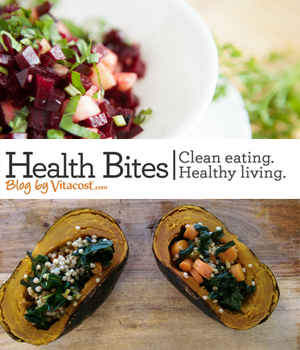Healthy Food Swaps to Lighten Your Favorite Recipes
Looking for some healthy food swaps? I’ve got a guest post for you from my friend Stu Lieberman – thanks Stu! I use these swaps and they make a big difference in my clean eating lifestyle. It’s all about eating well and feeling amazing without deprivation.
With some quick and easy modifications, you can turn just about any recipe into one that’s healthy and nutritious. Here are a few food swaps to trim the fat, cut calories, and make your favorite recipes even healthier.
If your recipe calls for…
Canola or Vegetable Oil: Swap out the oil for unsweetened applesauce to cut calories and fat. A ½ cup of vegetable oil carries 960 calories and 112 grams of fat. Compare that to natural, unsweetened applesauce, which delivers about 50 calories and 0 grams of fat per ½ cup serving. When you use applesauce in place of oil in baking, it’s a 1:1 ratio.
Sugar: Swap out the sugar for stevia. Stevia is a very sweet herb from the leaf of the stevia rebaudiana plant. This natural sweetener has a very low Glycemic Index and does not spike your blood sugar like regular sugar does. Stevia has also been found to support healthy blood pressure and dental health, and reduce incidences of candidiasis. The sweetener is calorie free. Compare that to one cup of refined sugar which contains over 770 calories. Due to stevia’s high sweetness (it’s actually sweeter than sugar), when you use powdered stevia in place of sugar, it’s a ¾:1 ratio. That means for every cup of sugar your recipe calls for, use ¾ of a cup of stevia.
Spaghetti: Swap out the spaghetti for spaghetti squash. Spaghetti squash is a hard winter squash that ranges in color from pale yellow to orangey-yellow. The more orange the squash, the more beta carotene it contains. When you cook the squash, the flesh develops threads that resemble spaghetti. The taste is somewhat mild, so it’s perfect the perfect partner to a ragu sauce. If you’re looking for a low carb alternative to spaghetti, this is the way to go. 1 cup of spaghetti squash has just 7 grams of carbs, vs 43 grams for a cup of spaghetti. And, a cup of spaghetti squash delivers just 30 calories, whereas the spaghetti gives you 220.
Milk Chocolate: Swap out the milk variety for dark chocolate containing at least 70% cocoa. Dark chocolate is loaded with antioxidants and has been shown to support healthy blood pressure and cholesterol levels. Dark chocolate also promotes satiety, so you feel fuller longer. When you use dark chocolate in place of milk chocolate, it is a 1:1 ratio.
One last tip. If you’re really craving ice cream, make your own ice cream with a banana. That’s right. Just one ripe, sweet banana. Peel the banana and cut it into evenly-sized slices. Put the slices in a freezer bag and freeze for at least 2 hours (overnight is better). Blend your frozen banana pieces until you have a creamy, custard-like texture. Eat the banana then, or re-freeze to firm it up. Enjoy the fat-free, sweet tasty treat with about a third the calories of premium ice cream.
This article is written by + Stu Lieberman the writer for Nutri-Health.com, an online High Quality Supplements such as PQQ. Assisting people and helping them find quality natural health supplements online is what Stu has been doing for over 3 years. Nutri-Health.com carries Digestive Supplements to Probiotics to Joint Health.


